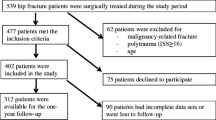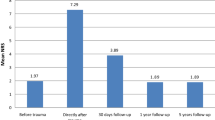Abstract
Geriatric fractures are an increasing medical problem worldwide. This article wants to give an overview on the literature concerning the outcome to be expected in geriatric fracture patients and what can be done to improve it. In literature, excess mortality rates vary from 12% to 35% in the first year after a hip fracture, and also, other geriatric fractures seem to reduce the patient’s remaining lifetime. Geriatric fractures and, in particular, hip fractures constitute a major source of disability and diminished quality of life in the elderly. Age, gender, comorbid conditions, prefracture functional abilities, and fracture type have an impact on the outcome regarding ambulation, activities of daily living, and quality of life. Comprehensive orthogeriatric comanagement might improve the outcome of geriatric fracture patients. For the future, well designed, large prospective randomized controlled trials with clear outcome variables are needed to finally prove the effectiveness of existing concepts.
Similar content being viewed by others
References
Johnell O, Kanis J (2005) Epidemiology of osteoporotic fractures. Osteoporos Int 16(Suppl 2):S3–S7
Cooper C, Campion G, Melton LJ (1992) Hip fractures in the elderly: a world-wide projection. Osteoporos Int 2:285–289
Johnell O (1997) The socioeconomic burden of fractures: today and in the 21st century. Am J Med 103:20S–25S, discussion 25 S–26 S
Sernbo I, Johnell O (1993) Consequences of a hip fracture: a prospective study over 1 year. Osteoporos Int 3:148–153
Giversen IM (2007) Time trends of mortality after first hip fractures. Osteoporos Int 18:721–732
Haleem S, Lutchman L, Mayahi R, Grice JE, Parker MJ (2008) Mortality following hip fracture: trends and geographical variations over the last 40 years. Injury 39:1157–1163
Center JR, Nguyen TV, Schneider D, Sambrook PN, Eisman JA (1999) Mortality after all major types of osteoporotic fracture in men and women: an observational study. Lancet 353:878–882
Johnell O, Kanis JA, Odén A, Sernbo I, Redlund-Johnell I, Petterson C, De Laet C, Jönsson B (2004) Mortality after osteoporotic fractures. Osteoporos Int 15:38–42
Bliuc D, Nguyen ND, Milch VE, Nguyen TV, Eisman JA, Center JR (2009) Mortality risk associated with low-trauma osteoporotic fracture and subsequent fracture in men and women. JAMA 301:513–521
Browner WS, Seeley DG, Vogt TM, Cummings SR (1991) Non-trauma mortality in elderly women with low bone mineral density. Study of osteoporotic fractures research group. Lancet 338:355–358
Johansson C, Black D, Johnell O, Odén A, Mellström D (1998) Bone mineral density is a predictor of survival. Calcif Tissue Int 63:190–196
Magaziner J, Simonsick EM, Kashner TM, Hebel JR, Kenzora JE (1990) Predictors of functional recovery one year following hospital discharge for hip fracture: a prospective study. J Gerontol 45:M101–M107
Koval KJ, Skovron ML, Aharonoff GB, Meadows SE, Zuckerman JD (1995) Ambulatory ability after hip fracture. A prospective study in geriatric patients Clin Orthop Relat Res 310:150–159
Cooper C (1997) The crippling consequences of fractures and their impact on quality of life. Am J Med 103:12S–17S, discussion 17 S–19 S
van Balen R, Steyerberg EW, Polder JJ, Ribbers TL, Habbema JD, Cools HJ (2001) Hip fracture in elderly patients: outcomes for function, quality of life, and type of residence. Clin Orthop Relat Res 390:232–243
Leibson CL, Tosteson ANA, Gabriel SE, Ransom JE, Melton LJ (2002) Mortality, disability, and nursing home use for persons with and without hip fracture: a population-based study. J Am Geriatr Soc 50:1644–1650
Rosell PAE, Parker MJ (2003) Functional outcome after hip fracture. A 1-year prospective outcome study of 275 patients. Injury 34:529–532
Boonen S, Autier P, Barette M, Vanderschueren D, Lips P, Haentjens P (2004) Functional outcome and quality of life following hip fracture in elderly women: a prospective controlled study. Osteoporos Int 15:87–94
Einsiedel T, Becker C, Stengel D, Schmelz A, Kramer M, Däxle M, Lechner F, Kinzl L, Gebhard F (2006) Do injuries of the upper extremity in geriatric patients end up in helplessness? A prospective study for the outcome of distal radius and proximal humerus fractures in individuals over 65. Z Gerontol Geriatr 39:451–461
Flierl MA, Gerhardt DC, Hak DJ, Morgan SJ, Stahel PF (2010) Key issues and controversies in the acute management of hip fractures. Orthopedics 33:102–110
British Orthopaedic Association (2007) Blue book - the care of patients with fragility fracture. http://wwwccadorguk/nhfdnsf/Blue_Bookpdf 1–74.
Nikolaou VS, Papathanasopoulos A, Giannoudis PV (2008) What’s new in the management of proximal femoral fractures? Injury 39:1309–1318
Egol KA, Strauss EJ (2009) Perioperative considerations in geriatric patients with hip fracture: what is the evidence? J Orthop Trauma 23:386–394
Mak JCS, Cameron ID, March LM, NHaMR C (2010) Evidence-based guidelines for the management of hip fractures in older persons: an update. Med J Aust 192:37–41
Hempsall VJ, Robertson DR, Campbell MJ, Briggs RS (1990) Orthopaedic geriatric care–is it effective? A prospective population-based comparison of outcome in fractured neck of femur. J R Coll Physicians Lond 24:47–50
Boyd RV, Hawthorne J, Wallace WA, Worlock PH, Compton EH (1983) The Nottingham orthogeriatric unit after 1000 admissions. Injury 15:193–196
Zuckerman JD, Sakales SR, Fabian DR, Frankel VH (1992) Hip fractures in geriatric patients. Results of an interdisciplinary hospital care program Clin Orthop Relat Res 274:213–225
Koval KJ, Chen AL, Aharonoff GB, Egol KA, Zuckerman JD (2004) Clinical pathway for hip fractures in the elderly: the Hospital for Joint Diseases experience. Clin Orthop Relat Res 425:72–81
Adunsky A, Lusky A, Arad M, Heruti RJ (2003) A comparative study of rehabilitation outcomes of elderly hip fracture patients: the advantage of a comprehensive orthogeriatric approach. J Gerontol A Biol Sci Med Sci 58:542–547
Adunsky A, Arad M, Levi R, Blankstein A, Zeilig G, Mizrachi E (2005) Five-year experience with the ‘Sheba’ model of comprehensive orthogeriatric care for elderly hip fracture patients. Disabil Rehabil 27:1123–1127
Vidan M, Serra JA, Moreno C, Riquelme G, Ortiz J (2005) Efficacy of a comprehensive geriatric intervention in older patients hospitalized for hip fracture: a randomized, controlled trial. J Am Geriatr Soc 53:1476–1482
Friedman SM, Mendelson DA, Kates SL, McCann RM (2008) Geriatric co-management of proximal femur fractures: total quality management and protocol-driven care result in better outcomes for a frail patient population. J Am Geriatr Soc 56:1349–1356
Friedman SM, Mendelson DA, Bingham KW, Kates SL (2009) Impact of a comanaged geriatric fracture center on short-term hip fracture outcomes. Arch Intern Med 169:1712–1717
Handoll HH, Cameron ID, Mak JC, Finnegan TP (2009) Multidisciplinary rehabilitation for older people with hip fractures. Cochrane Database Syst Rev CD007125
Conflicts of interest
T. Roth, none; C. Kammerlander, teaching activities with Synthes; M. Gosch, none; T.J. Luger, none; M. Blauth, consultant and teaching activities with Synthes.
Author information
Authors and Affiliations
Corresponding author
Rights and permissions
About this article
Cite this article
Roth, T., Kammerlander, C., Gosch, M. et al. Outcome in geriatric fracture patients and how it can be improved. Osteoporos Int 21 (Suppl 4), 615–619 (2010). https://doi.org/10.1007/s00198-010-1401-4
Received:
Accepted:
Published:
Issue Date:
DOI: https://doi.org/10.1007/s00198-010-1401-4




